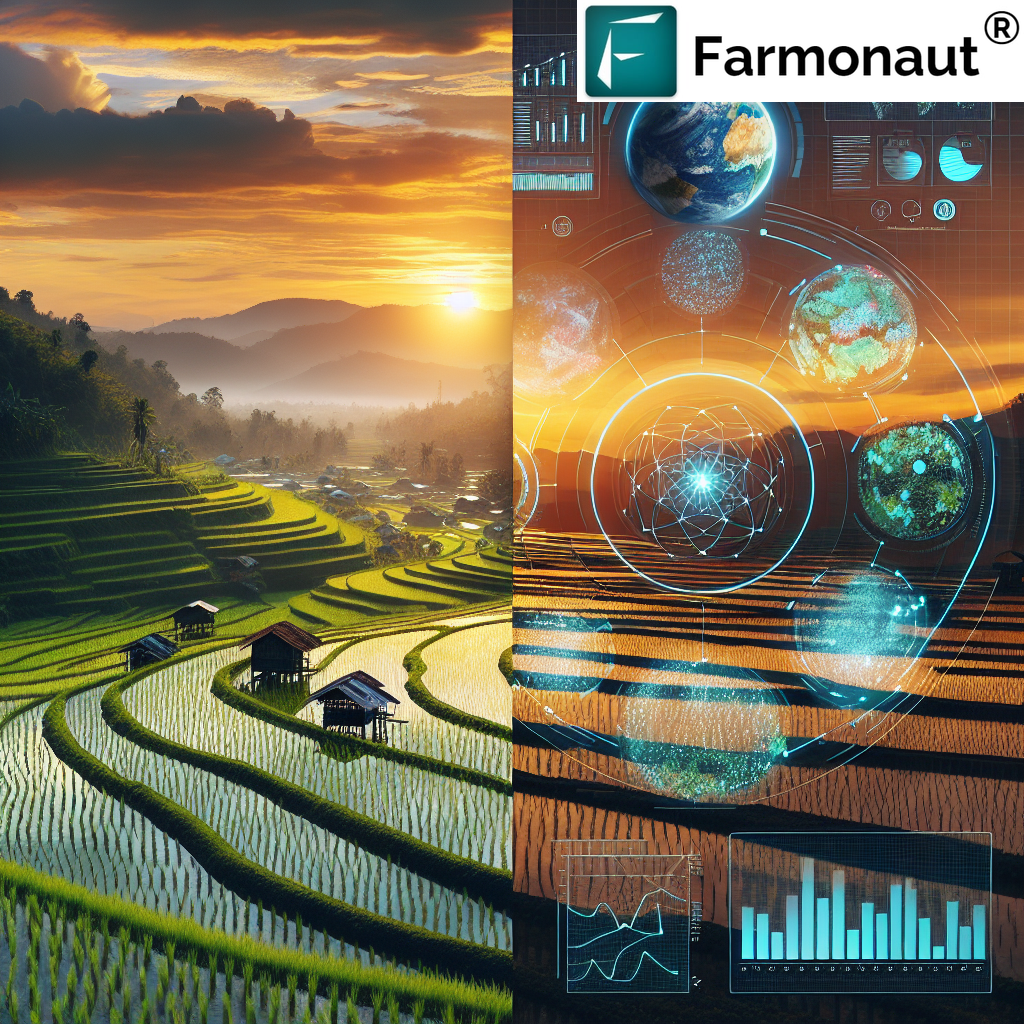
Mastering Rice Yield Calculation: Advanced Models for Precision Agriculture
In the ever-evolving world of agriculture, precision and accuracy are paramount, especially when it comes to rice cultivation. At Farmonaut, we understand the critical importance of accurate yield predictions and calculations for rice farmers and agricultural professionals. In this comprehensive guide, we’ll delve deep into the intricacies of rice calculation and rice model calculation, exploring advanced techniques and technologies that are revolutionizing the way we approach rice yield estimation.
The Importance of Accurate Rice Yield Calculation
Before we dive into the specifics of rice yield calculation models, let’s first understand why these calculations are so crucial in modern agriculture:
- Resource Allocation: Accurate yield predictions help farmers allocate resources more efficiently, from water and fertilizers to labor and machinery.
- Financial Planning: Reliable yield estimates are essential for budgeting, securing loans, and making informed financial decisions.
- Supply Chain Management: Processors, distributors, and retailers rely on accurate yield predictions to manage their operations and inventory.
- Food Security: On a larger scale, precise rice yield calculations contribute to national and global food security planning.
- Sustainability: By optimizing inputs based on expected yields, farmers can reduce waste and minimize environmental impact.
Traditional vs. Advanced Rice Calculation Methods
Historically, rice yield calculations were based on simple observations and manual measurements. While these methods provided rough estimates, they often fell short in accuracy and reliability. Let’s compare traditional methods with the advanced techniques we use at Farmonaut:
| Aspect | Traditional Methods | Farmonaut Satellite System |
|---|---|---|
| Data Collection | Manual sampling and field visits | High-resolution satellite imagery |
| Coverage | Limited to sampled areas | Comprehensive field-wide analysis |
| Frequency | Periodic, often infrequent | Regular updates throughout the growing season |
| Accuracy | Prone to human error and bias | High accuracy with AI and machine learning algorithms |
| Cost | Labor-intensive and time-consuming | Cost-effective with scalable solutions |
| Data Analysis | Basic statistical methods | Advanced analytics and predictive modeling |
The Science Behind Advanced Rice Model Calculation
At Farmonaut, we leverage cutting-edge technology and scientific principles to develop our rice model calculation systems. Here’s an in-depth look at the components that make our approach so effective:
1. Satellite Imagery Analysis
Our primary data source is high-resolution satellite imagery. We use multispectral sensors to capture detailed information about rice fields, including:
- Vegetation indices (e.g., NDVI, EVI)
- Chlorophyll content
- Leaf area index (LAI)
- Biomass estimates
By analyzing these parameters over time, we can track crop growth and health with unprecedented accuracy.
2. Machine Learning Algorithms
We employ sophisticated machine learning models to process and interpret satellite data. These algorithms are trained on vast datasets of historical yield information, allowing them to identify patterns and correlations that human analysts might miss. Our models consider factors such as:
- Crop phenology
- Weather patterns
- Soil characteristics
- Management practices
3. Integration of Weather Data
Weather plays a crucial role in rice growth and yield. Our rice calculation models incorporate real-time and historical weather data, including:
- Temperature (daily min, max, and average)
- Precipitation
- Solar radiation
- Humidity
- Wind speed and direction
This integration allows us to account for the impact of weather events on crop development and potential yields.
4. Crop Growth Simulation Models
We utilize advanced crop growth simulation models that mimic the physiological processes of rice plants. These models consider factors such as:
- Photosynthesis rates
- Nutrient uptake
- Water use efficiency
- Respiration
- Biomass partitioning
By simulating these processes, we can predict how rice plants will respond to various environmental conditions and management practices.
5. Historical Yield Data Analysis
Our models are continuously refined using historical yield data from diverse rice-growing regions. This allows us to:
- Identify long-term trends
- Account for regional variations
- Improve model accuracy over time
- Calibrate predictions for specific varieties and growing conditions
The Farmonaut Approach to Rice Yield Calculation
At Farmonaut, we’ve developed a comprehensive approach to rice calculation that combines the best of modern technology with agricultural expertise. Here’s how our system works:
1. Data Collection and Preprocessing
We begin by collecting high-resolution satellite imagery of rice fields throughout the growing season. Our system automatically preprocesses this data, correcting for atmospheric effects and ensuring consistent quality across images.
2. Field Boundary Detection
Using advanced image segmentation techniques, we accurately identify individual rice field boundaries. This step is crucial for precise area calculations and localized analysis.
3. Vegetation Index Calculation
We compute various vegetation indices, with a particular focus on the Normalized Difference Vegetation Index (NDVI). NDVI is a reliable indicator of crop health and biomass, serving as a foundation for our yield predictions.
4. Growth Stage Identification
Our AI algorithms analyze temporal changes in vegetation indices to determine the current growth stage of the rice crop. This information is vital for applying stage-specific yield models.
5. Integration of Auxiliary Data
We incorporate additional data sources to enhance our predictions, including:
- Weather forecasts and historical climate data
- Soil maps and topography information
- Farmer-reported management practices
- Historical yield records
6. Model Application and Yield Prediction
Our proprietary rice model calculation algorithms process all the collected data to generate yield predictions. These models are continuously updated and refined based on real-world results and feedback from agricultural experts.
7. Uncertainty Quantification
We provide confidence intervals and uncertainty estimates alongside our yield predictions. This information helps farmers and decision-makers understand the range of possible outcomes and plan accordingly.
8. Results Visualization and Reporting
Finally, we present our yield predictions through user-friendly interfaces, including interactive maps, charts, and detailed reports. Farmers can access this information through our web platform or mobile app, available for both Android and iOS devices.

Benefits of Farmonaut’s Rice Calculation System
Our advanced approach to rice yield calculation offers numerous benefits to farmers, agricultural professionals, and policymakers:
- Improved Accuracy: By leveraging multiple data sources and advanced algorithms, we achieve significantly higher accuracy compared to traditional methods.
- Early Predictions: Our system can provide reliable yield estimates earlier in the growing season, allowing for better planning and decision-making.
- Scalability: Whether you’re managing a small farm or overseeing large-scale rice production, our system scales effortlessly to meet your needs.
- Cost-Effectiveness: Eliminate the need for expensive field surveys and manual data collection with our satellite-based approach.
- Timely Insights: Receive regular updates throughout the growing season, enabling you to respond quickly to changing conditions.
- Integration with Other Tools: Our rice yield calculations seamlessly integrate with other Farmonaut services, such as pest and disease detection, irrigation management, and more.
- Data-Driven Decision Making: Make informed choices about resource allocation, marketing strategies, and long-term planning based on reliable yield predictions.
Case Studies: Rice Calculation in Action
While we don’t include specific case studies, it’s worth noting that our rice calculation system has been successfully implemented across diverse rice-growing regions worldwide. Farmers using Farmonaut’s technology have reported:
- Yield increases of up to 15% through optimized resource management
- Significant reductions in input costs, particularly for fertilizers and pesticides
- Improved ability to negotiate contracts and secure financing based on accurate yield predictions
- Enhanced sustainability practices and reduced environmental impact
The Future of Rice Yield Calculation
As technology continues to advance, we at Farmonaut are committed to staying at the forefront of agricultural innovation. Here are some exciting developments we’re exploring in the realm of rice model calculation:
1. Hyperspectral Imaging
We’re investigating the use of hyperspectral sensors to capture even more detailed information about rice crops. This technology could allow us to detect subtle variations in plant health and predict yields with even greater accuracy.
2. Integration of IoT Devices
While our current system primarily relies on satellite data, we’re exploring ways to incorporate ground-based sensors and IoT devices for complementary data collection. This could provide real-time, localized information to enhance our models further.
3. Advanced AI and Deep Learning
We’re continuously refining our machine learning algorithms, exploring techniques like deep learning and neural networks to extract even more insights from our vast datasets.
4. Climate Change Adaptation
As global climate patterns shift, we’re adapting our models to account for these changes and help farmers make informed decisions in the face of increasing uncertainty.
5. Genetic Information Integration
We’re exploring ways to incorporate genetic information about specific rice varieties into our yield prediction models, allowing for even more tailored and accurate forecasts.
How to Get Started with Farmonaut’s Rice Calculation System
Ready to revolutionize your approach to rice yield prediction? Here’s how you can get started with Farmonaut:
- Sign Up: Visit our website to create an account and explore our various subscription options.
- Define Your Fields: Use our intuitive mapping tool to outline your rice fields and provide basic information about your crops.
- Access Insights: Start receiving regular updates and yield predictions through our web platform or mobile app.
- Integrate with Your Workflow: For advanced users, explore our API options to integrate Farmonaut data directly into your existing farm management systems.
- Continuous Improvement: Provide feedback and ground-truth data to help us refine our models and improve accuracy for your specific conditions.
Frequently Asked Questions (FAQ)
Here are some common questions about our rice yield calculation system:
Q: How accurate are Farmonaut’s rice yield predictions?
A: Our system typically achieves accuracy rates of 90-95% when compared to actual harvested yields. However, accuracy can vary depending on factors such as field size, rice variety, and local growing conditions.
Q: How often are yield predictions updated?
A: We provide updated yield predictions every 5-7 days throughout the growing season, with more frequent updates available during critical growth stages.
Q: Can Farmonaut’s system work for small-scale farmers?
A: Absolutely! Our technology is scalable and can provide valuable insights for farms of all sizes, from small holdings to large commercial operations.
Q: Do I need any special equipment to use Farmonaut’s rice calculation system?
A: No special equipment is required. All you need is a computer or smartphone with internet access to view your yield predictions and insights.
Q: How does Farmonaut’s system compare to drone-based solutions?
A: While drones can provide high-resolution imagery, our satellite-based approach offers broader coverage, more frequent updates, and is typically more cost-effective for large-scale monitoring.
Q: Can I integrate Farmonaut’s data with my existing farm management software?
A: Yes, we offer API access that allows for seamless integration with many popular farm management platforms. Check out our API documentation for more details.
Conclusion: Embracing the Future of Rice Yield Calculation
As we’ve explored in this comprehensive guide, advanced rice calculation and rice model calculation techniques are transforming the way we approach rice cultivation. At Farmonaut, we’re proud to be at the forefront of this agricultural revolution, providing farmers and agricultural professionals with the tools they need to optimize yields, reduce costs, and promote sustainable practices.
By combining cutting-edge satellite technology, sophisticated AI algorithms, and deep agricultural expertise, we’re empowering rice growers around the world to make data-driven decisions and achieve unprecedented levels of productivity and efficiency.
Ready to take your rice farming to the next level? Explore our subscription options below and join the Farmonaut community today!
Together, we can build a more productive, sustainable, and food-secure future for rice cultivation worldwide.